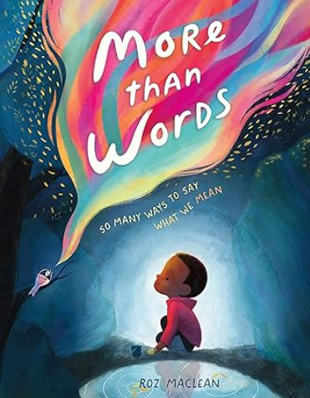In this book, award-winning Canadian illustrator and author Roz MacLean celebrates the myriad of ways we express ourselves, through the lens of a child named Nathan who "doesn't say much" but "has a lot on his mind." The other children at Nathan's school show the many ways to say something: out loud, by facial expression, in writing, in Braille, in sign language, by using Point-and-Press, by singing, building, art, and much more.
MacLean's words are enthusiastic and encouraging; for instance:
"You might want to show your
spark, style, and pizzazz
with what you WEAR!"
and her gouache, pencil crayon, acrylic ink, and digital illustrations gorgeously invite us into a world bursting with modes of self-expression. The above text is partially written on a rainbow-colored scarf that one child is pulling out of a treasure chest. Each letter in the word "WEAR" is an article of clothing hung on a line. And altogether in this single picture we see six children, each dressed as uniquely as can be, like a kid with wide sunglasses, a baseball cap, sneakers, a pink tutu, and fairy wings, gazing into a mirror with a flower-petal frame.
This book conveys the beauty of diversity in ways integral to the story and as inclusive as any book we've ever seen. It shows us many different ethnicities, a child with a service dog, a child who "can't always think of words but she can MOVE" (shown with her turning cartwheels and tossing leaves that spell out "MOVE"), a child using supplemental oxygen, a bald child, and a child in a wheelchair — and that only scratches the surface of those illustrated.
The story circles back to Nathan and the way that he communicates by drawing all his classmates together in a shared, quiet offering to Nature. Closing resource pages delve into the why and how of communication, the forms of Augmentative and Alternative Communication (AAC) pictured in the book — like text-to-speech and symbol-to-speech technology — and ways to help everyone have communication access, such as:
"Presume competence: Believe someone can understand you and express themselves if they have the right tools and they learn how to use those tools."
Elementary-school children will be able to see themselves in these pages. They will feel that their style of communication is valid and welcomed, part of a wide array of ways we can get to know each other.
